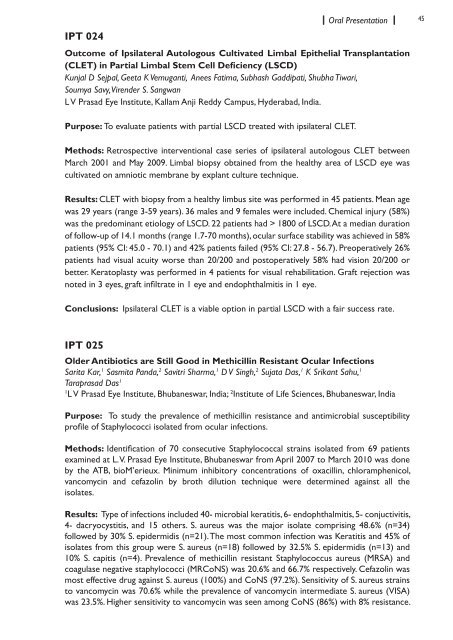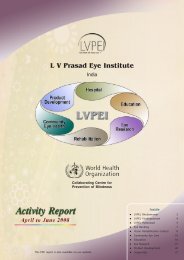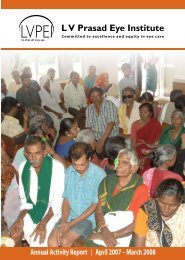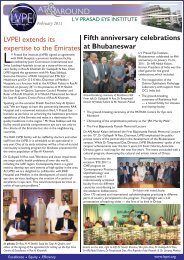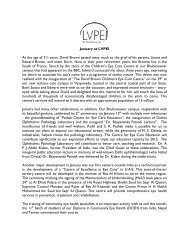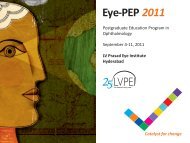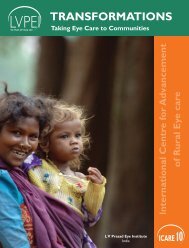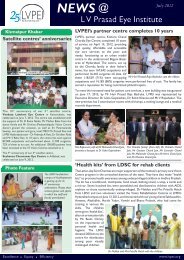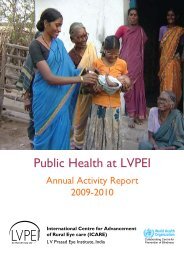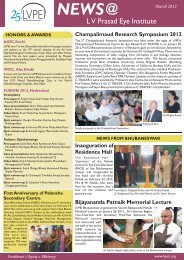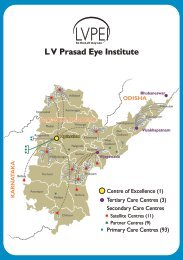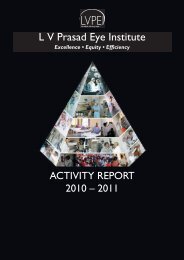IERG Abstracrt Book.indd - LV Prasad Eye Institute
IERG Abstracrt Book.indd - LV Prasad Eye Institute
IERG Abstracrt Book.indd - LV Prasad Eye Institute
You also want an ePaper? Increase the reach of your titles
YUMPU automatically turns print PDFs into web optimized ePapers that Google loves.
IPT 024Oral Presentation45Outcome of Ipsilateral Autologous Cultivated Limbal Epithelial Transplantation(CLET) in Partial Limbal Stem Cell Deficiency (LSCD)Kunjal D Sejpal, Geeta K Vemuganti, Anees Fatima, Subhash Gaddipati, Shubha Tiwari,Soumya Savy, Virender S. SangwanL V <strong>Prasad</strong> <strong>Eye</strong> <strong>Institute</strong>, Kallam Anji Reddy Campus, Hyderabad, India.Purpose: To evaluate patients with partial LSCD treated with ipsilateral CLET.Methods: Retrospective interventional case series of ipsilateral autologous CLET betweenMarch 2001 and May 2009. Limbal biopsy obtained from the healthy area of LSCD eye wascultivated on amniotic membrane by explant culture technique.Results: CLET with biopsy from a healthy limbus site was performed in 45 patients. Mean agewas 29 years (range 3-59 years). 36 males and 9 females were included. Chemical injury (58%)was the predominant etiology of LSCD. 22 patients had > 1800 of LSCD. At a median durationof follow-up of 14.1 months (range 1.7-70 months), ocular surface stability was achieved in 58%patients (95% CI: 45.0 - 70.1) and 42% patients failed (95% CI: 27.8 - 56.7). Preoperatively 26%patients had visual acuity worse than 20/200 and postoperatively 58% had vision 20/200 orbetter. Keratoplasty was performed in 4 patients for visual rehabilitation. Graft rejection wasnoted in 3 eyes, graft infiltrate in 1 eye and endophthalmitis in 1 eye.Conclusions: Ipsilateral CLET is a viable option in partial LSCD with a fair success rate.IPT 025Older Antibiotics are Still Good in Methicillin Resistant Ocular InfectionsSarita Kar, 1 Sasmita Panda, 2 Savitri Sharma, 1 D V Singh, 2 Sujata Das, 1 K Srikant Sahu, 1Taraprasad Das 11L V <strong>Prasad</strong> <strong>Eye</strong> <strong>Institute</strong>, Bhubaneswar, India; 2 <strong>Institute</strong> of Life Sciences, Bhubaneswar, IndiaPurpose: To study the prevalence of methicillin resistance and antimicrobial susceptibilityprofile of Staphylococci isolated from ocular infections.Methods: Identification of 70 consecutive Staphylococcal strains isolated from 69 patientsexamined at L. V. <strong>Prasad</strong> <strong>Eye</strong> <strong>Institute</strong>, Bhubaneswar from April 2007 to March 2010 was doneby the ATB, bioM’erieux. Minimum inhibitory concentrations of oxacillin, chloramphenicol,vancomycin and cefazolin by broth dilution technique were determined against all theisolates.Results: Type of infections included 40- microbial keratitis, 6- endophthalmitis, 5- conjuctivitis,4- dacryocystitis, and 15 others. S. aureus was the major isolate comprising 48.6% (n=34)followed by 30% S. epidermidis (n=21). The most common infection was Keratitis and 45% ofisolates from this group were S. aureus (n=18) followed by 32.5% S. epidermidis (n=13) and10% S. capitis (n=4). Prevalence of methicillin resistant Staphylococcus aureus (MRSA) andcoagulase negative staphylococci (MRCoNS) was 20.6% and 66.7% respectively. Cefazolin wasmost effective drug against S. aureus (100%) and CoNS (97.2%). Sensitivity of S. aureus strainsto vancomycin was 70.6% while the prevalence of vancomycin intermediate S. aureus (VISA)was 23.5%. Higher sensitivity to vancomycin was seen among CoNS (86%) with 8% resistance.


